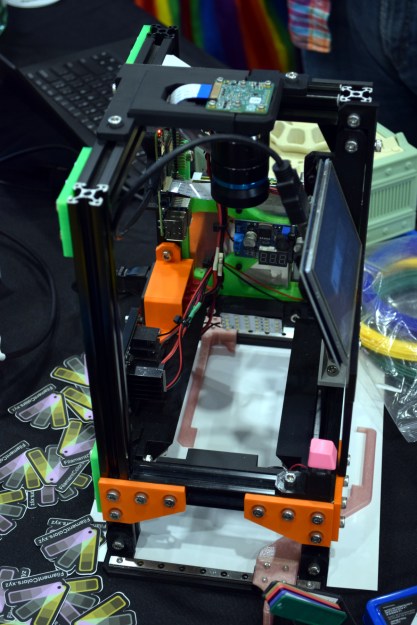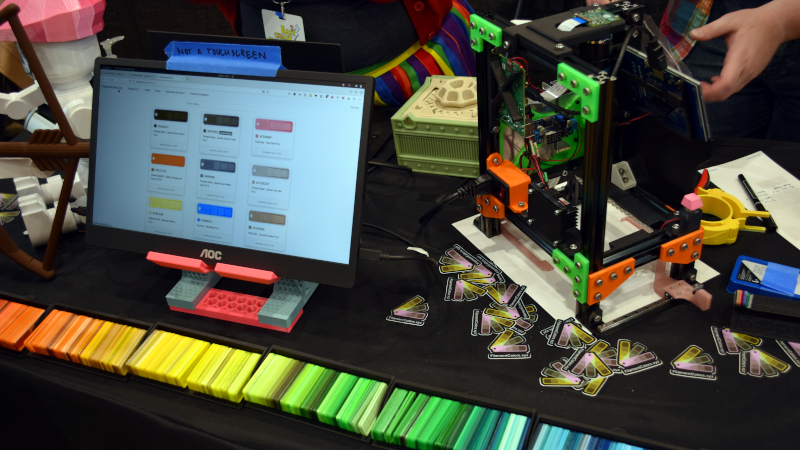If you’ve ever paged through the color samples at the hardware store trying to match a particular color, you know how hard it can be. Not only are there nearly limitless color variations, but each manufacturer has their own formulas and tints. Often times, the only way to get the exact color you need is to get it custom mixed.
Unfortunately, that’s not really an option when it comes to filament for your 3D printer. Will that roll of orange from Hatchbox actually match the orange from Overture? That’s where the Filament Librarian comes in. Created by [Joe Kaufeld], the project aims to catalog and photograph as many 3D printer filaments as possible so you can see exactly what you’re getting.
 Now of course, if it was as easy as looking at pictures of filament swatches on your computer, you wouldn’t need this service to begin with. So what’s the trick? A custom automated camera rig, powered by the Raspberry Pi, is used to position, light, and photograph each filament sample in the library. So while [Joe] can’t promise your monitor is showing a perfect representation of each filament’s color, you can at least be sure they will all look correct in relation to each other. So for example, the site can help you figure out if the local Microcenter stocks anything that comes close to matching Prusament’s Galaxy Silver PLA.
Now of course, if it was as easy as looking at pictures of filament swatches on your computer, you wouldn’t need this service to begin with. So what’s the trick? A custom automated camera rig, powered by the Raspberry Pi, is used to position, light, and photograph each filament sample in the library. So while [Joe] can’t promise your monitor is showing a perfect representation of each filament’s color, you can at least be sure they will all look correct in relation to each other. So for example, the site can help you figure out if the local Microcenter stocks anything that comes close to matching Prusament’s Galaxy Silver PLA.
[Joe] brought a collection of his samples along with his slick camera setup to the 2022 East Coast RepRap Festival so attendees could see first-hand how he adds a new filament to the database. With an easy-to-use touch-screen interface, it takes just seconds to get the camera ready for the next shot.
Now that he’s got the hardware and the procedure down, [Joe] is asking the community to help out by providing him with filament samples to process. It doesn’t take much: all he asks is you snip him off a couple meters of filament, write down what it is and who makes it on a pre-made form, and drop it in the mail. If you’re in the US, you can send it directly to his address in Indiana, and for those on the other side of the globe, he’s got a drop point in the Netherlands you can use.
We love a good passion project here at Hackaday, so here’s hoping that the Filament Librarian receives plenty of new filament samples from all over the planet to feed into that fancy camera setup of his.

















Cool!
Now I want an article about color calibration :)
I tried to do that years ago. Unfortunately, most suppliers do not maintain strict color consistency over time. Often, they make a master batch of colorant which is used in production until the master batch runs out. This might be months or years depending on how much of that colorant is used to produce the spools.
Then a new master batch is made which may be close enough or not close at all.
There are pro color compounders that go through a lot of extra work to ensure color consistency when producing the master batch and the final plastic. But they add a lot of cost to the process.
Exactly my experience with 3dprima’s batches in the past. Even though they told me they don’t have variances, They at least had batch numbers on their filemant (throughout which the colours where consistent) but the final reason had to abandon abandon them. Having good results with other premium filament suppliers but just opted for buying abundant amounts of filament if i really need the same colour throughout.
I go for wood glue + acrylic lack (mtn is great for consistent colours) nowadays for most prints to not having the need of having vast amounts of filament at home.
Will this work as intended?
I’ve bought same brand filament from micro center multiple times. Rarely is the same named color the same physical color.
The first red I bought was a deep red shiney color, the latest was a flat bright red.
The first silver was indistinguishable from grey, the latest was really shiny silver.
That is common even for paint. Batch numbers need to match to get the same color.
I wish things were more consistent.
I’d say it will work well enough – as while batch to batch variation isn’t unexpected the batches should all be pretty damn close to each other if there is anything resembling quality in the production.
When it comes to colour matching either you do it yourself taking however many iterations it takes to match the existing, spend heaps for the really high quality super well colour graded stuff every time or put up with something rather close but not perfect – and this tool aught to get you to that level of close just fine I’d think… Which is massively better than having no idea as the photo on the website store pages are usually from different sources, under different lighting etc so are likely of no use…
I bought two spools of black PLA from Gizmodorks. One was black black and the other was like a really dark grey. You could tell the difference when one spool ran out in the middle of a part. I contacted them and they sent me another for free though, so that’s cool. The replacement was the grey/black too.
I wonder if adding a prism and a CCD array from a scanner would compliment this design by giving you are spectrogram too, just remember to use a broad spectrum light source and not LED lighting.
“you can at least be sure they will all look correct in relation to each other”. No, not really. You can expect that they will look the same when viewed through that camera and under very specific lighting. Two pigments that seem “the same” under sunlight may look noticeably different when illuminated with LEDs. The effect may not be very pronounced with high-quality “natural white” LEDs, because they tend to immitate the white spectrum quite well, but with a “spiky” light spectrum you can get wild results.
Colors are hard.
> Colors are hard
+1
> Colors are hard.
Colors are very hard. I visited a plastic compounder once – the amount of work that goes into color matching is insane. They have a dedicated room just to verify color performance under different lighting conditions.
Small color shifts can occur due to different printing conditions. Extrusion temperature, cooling, layer thickness, print speed, and printer rigidity can change things enough to have noticeable shifts in appearance.
Colors are also hard because every consumer has their specific likes/dislikes and opinions. A color registry is helpful in that regard. But it is hard.